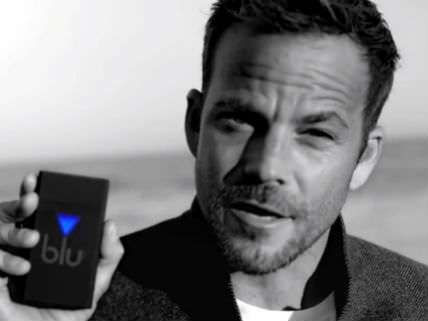Censors Worry About 'E-Cigarette Ads Aimed at Youths' But Can't Identify Any
- OurStudio

- Jul 23, 2014
- 3 min read

Blu eCig ad
"Officials Focus on E-Cigarette Ads Aimed at Youths," says the headline over a New York Times story about a gathering of state attorneys general in Park City, Utah. Which ads are those, and how old are these "youths"? The article never really answers either question, and you can tell from the lead that reporter Eric Lipton prefers to keep things vague:
State attorneys general must investigate, and consider taking legal action against, e-cigarette companies that appear to be using some of the same advertising tactics that once drew young adults into smoking, a Kentucky deputy attorney general told his law enforcement colleagues gathered here for a retreat to discuss emerging legal issues in states nationwide.
Since when is selling e-cigarettes (or conventional cigarettes) to adults, let alone telling them about the product, grounds for "legal action"? Lipton implies that states have the authority to censor or punish speech that offends them. They don't, even when the rationale is shielding minors from messages about adult products. They certainly do not have that power when the avowed goal is protecting adults from information that might lead them to buy products that certain state officials do not like.
Lipton reports that "one question debated at the gathering this week has been whether state attorneys general should try to force e-cigarette companies to comply with the same standards imposed on tobacco companies." Those standards, which include a ban on outdoor advertising, are part of the 1998 "master settlement agreement" that resolved state-sponsored litigation against the leading cigarette manufacturers. Since e-cigarette companies not only were not part of that litigation but did not exist when the lawsuits were settled, how can they possibly be compelled to follow the terms of that agreement?
Later in the article Lipton does mention "children," by which he presumably means people younger than 18, which most states and the Food and Drug Administration have set as the minimum purchase age for e-cigarettes. What is the evidence that e-cigarette ads are "aimed at" children, as the headline asserts? Lipton mentions "e-cigarettes with flavors like Cherry Crush and Peach Schnapps, which are sold by the e-cigarette company Blu and may be particularly appealing to children." They also may be particularly appealing to adults. In fact, they are.
What else is there to the case that e-cigarette companies are luring children into nicotine habits? Not much:
[Sean Riley, Kentucky's chief deputy attorney general,] and Matthew L. Myers, president of the Campaign for Tobacco-Free Kids, both ran through a series of recent e-cigarette advertisements that echo techniques once used by tobacco companies, like cartoon characters that are using e-cigarettes, or advertisements that feature celebrities like Courtney Love and Robert Pattinson. The e-cigarette industry has also started advertising at sporting events where tobacco ads are banned. The problems are particularly acute, the officials said, with less traditional forms of advertising, like on YouTube and other social media sites.
You may be thinking that you have not noticed a whole lot of ads with cartoon characters using e-cigarettes. So what is Myers talking about? He is talking about "Bob," a short-lived comic-book-style character featured on Blu's website (which, for what it's worth, is officially restricted to "adults 18 years or older"). To Myers, Bob looks a lot like Joe Camel. Personally, I don't see it. In any event, Blu killed off Bob, anticipating precisely this sort of inane complaint, which is based on the demonstrably false premise that cartoons (like fruit flavors!) appeal only to children.
Similarly, Robert Pattinson, who became a celebrity by playing a dreamy vampire in the Twilight movies, may indeed have a special place in the hearts of tween girls, but presumably his appeal is wider than that. And Courtney Love? Are you kidding me? Does anyone under 18 even know who she is? Myers likewise argues that Steven Dorff and Jenny McCarthy, whom you may or may not remember from their heydays two decades ago, are particularly appealing to young people these days. He also maintains that advertising featuring "rugged men" (Steven Dorff again!) or sexy women is clearly intended for kids.
Myers is on firmer ground in suggesting that teenagers have been known to attend sporting events and use social media. But you know who else likes those things? Adults.
Critics such as Myers and Riley are implicitly arguing that e-cigarette ads should be limited to techniques that repel teenagers and, just to be extra safe, should never appear in settings where they might be seen by anyone younger than 18. Whether or not that position strikes you as reasonable, any attempt to enforce it by law would be clearly unconstitutional, so all this talk about "taking legal action" and imposing "standards" is nothing more than busybody bluster.




Comments